红色阳离子活性染料的制备毕业论文
2020-07-01 20:50:09
摘 要
活性染料是一类能与纤维通过化学反应生成共价键的反应性染料。在传统的染色工艺中,该染料上染纤维素纤维需要加入大量的无机盐进行促染,导致了水质的恶化和生态环境的破坏。因而,开发环保型无盐低盐染色的活性染料成为主要研究方向。含有阳离子基团的阳离子活性染料可在无盐的条件下对棉纤维进行上染。目前,阳离子活性染料结构中的阳离子以芳胺类季钱盐和脂肪族季按化合物为主,其染料母体主要是偶氮类、蒽醌类和杂环类
本文以1-氨基蒽醌、分散红60、分散红369为染料母体,分别采用不同的合成方法得到不同的四种红色阳离子活性染料。将分散红60与三聚氯氰反应,染料的一个羟基和氯基发生取代反应,然后以205(聚乙二醇二缩水甘油醚)和二甲胺反应,所得到的产物与上一步的产物的一个氯基反应得到一种红色阳离子活性染料。1-氨基蒽醌与环氧氯丙烷反应,PEG1000与三聚氯氰反应再与N,N-二甲基乙二胺反应,然后与第一步的产物反应生成第二种红色阳离子活性染料。PEG2000与三聚氯氰反应,再与分散红369反应得到第三种红色阳离子活性染料。分散红60与环氧氯丙烷反应,PEG1000与三聚氯氰反应再与N,N-二甲基乙醇胺反应,然后与第一步的产物反应生成第四种红色阳离子活性染料。将这四种染料都进行了紫外光谱测试。第一种染料进行季铵化后进行了无盐染色实验,测定其染色性能。色牢度好,染色颜色深,上染率高,但色匀度不好。
关键词
阳离子活性染料,无盐染色,季铵阳离子,高分子染料,染色性能
Synthesis of Red Cationic Reactive Dyes
Abstract
Reactive dyes are reactive dyes that react chemically with fibers to form covalent bonds. In the traditional dyeing process, the dyeing of cellulose fibers requires the addition of a large amount of inorganic salts to promote dyeing, resulting in deterioration of water quality and destruction of the ecological environment. Therefore, the development of environmentally friendly salt-free low-salt dye reactive dyes has become the main research direction. Cationic reactive dyes containing cationic groups can be used to dye cotton fibers in the absence of salt. At present, the cations in the structure of cationic reactive dyes are dominated by arylamine quaternary salts and aliphatic quarters. The dye precursors are mainly azo compounds, onion awakenings and heterocycles.
In this paper, 1-aminoanthraquinone, disperse red 60, and disperse red 369 were used as the dye matrix, and four different red cation reactive dyes were obtained by different synthesis methods. Reaction of disperse red 60 with cyanuric chloride, a substitution reaction between a hydroxyl group and a chlorine group of the dye, followed by reaction of 205 with dimethylamine, and the resulting product reacts with a chlorine group of the product of the previous step to obtain a red cation Reactive dyes. 1-Aminoanthraquinone reacts with epichlorohydrin, PEG 1000 reacts with cyanuric chloride and reacts with N,N-dimethylethylenediamine, and then reacts with the product of the first step to form a second red cationic reactive dye. PEG2000 reacted with cyanuric chloride and reacted with disperse red 369 to give a third red cationic reactive dye. Disperse red 60 reacts with epichlorohydrin, PEG 1000 reacts with cyanuric chloride and then reacts with N,N-dimethylethanolamine, and then reacts with the product of the first step to form a fourth red cationic reactive dye. All four dyes were tested in the UV spectrum. After the first dye was quaternized, a salt-free dyeing experiment was performed to determine its dyeing performance. Good color fastness, deep coloration, high dye uptake, but poor color uniformity.
Key words:
Cationic reactive dyes, salt-free dyeing, quaternary ammonium cations, polymer dyes, dyeing,Color performance
目录
摘 要 I
Abstract II
第一章 绪论 1
1.1活性染料 1
1.1.1活性染料的分类 1
1.1.2活性染料的特点 3
1.1.3活性染料的应用 4
1.1.4活性染料的染色方法及过程 5
1.2阳离子活性染料 6
1.2.1阳离子活性染料的发展现状 6
1.2.2阳离子活性染料的结构类型 7
1.2.3阳离子活性染料的合成 8
1.2.4阳离子活性染料的前景展望 8
第二章 实验部分 10
2.1仪器和药品 10
2.1.1药品 10
2.1.2仪器 10
2.2染料的合成 11
2.3阳离子活性染料的染色性能测试实验 15
第三章 实验结果与讨论 17
3.1产物结构及理化性质 17
3.2 RCRD1阳离子活性染料的染色性能 19
第四章 结论 23
参考文献 24
致谢 26
第一章 绪论
1.1活性染料
活性染料起源于1954年ICI公司的Rattee和Stephen制造了一种染料并发现它可以和纤维素纤维共价结合,后来这种染料被称为活性染料。60多年来,活性染料得到了飞速的发展,它的发展历史可分为三个阶段:1956年到1976年,开发了20于个活性基;开发了两个及两个以上的多活性基染料;活性染料进入高层次的实用阶段。
活性染料的化学结构通式为:
相关图片展示:
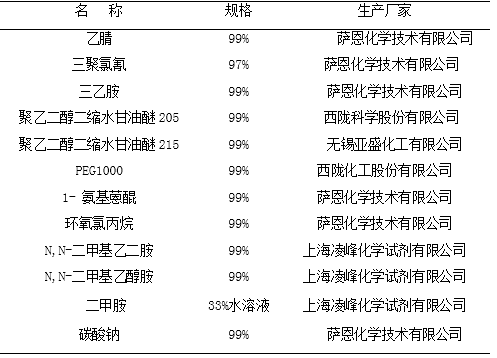
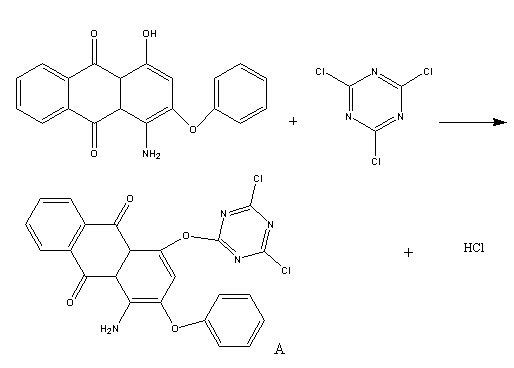
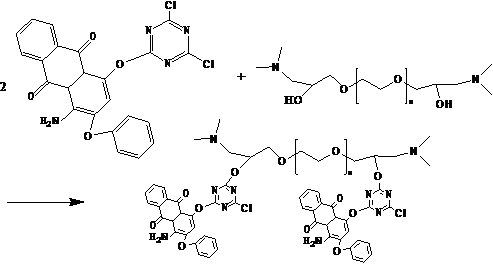
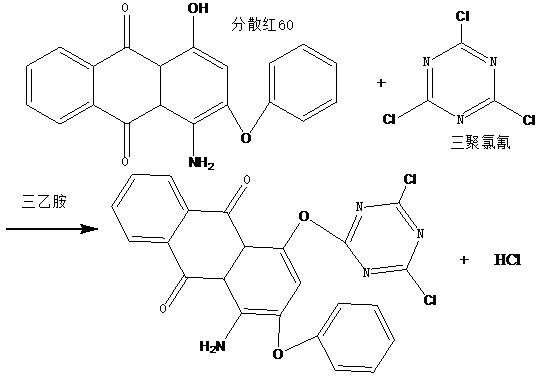
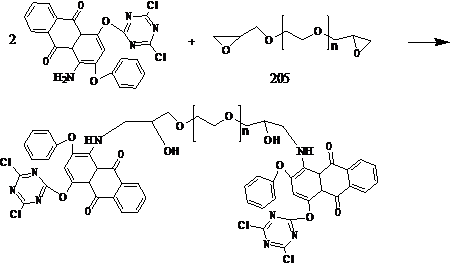
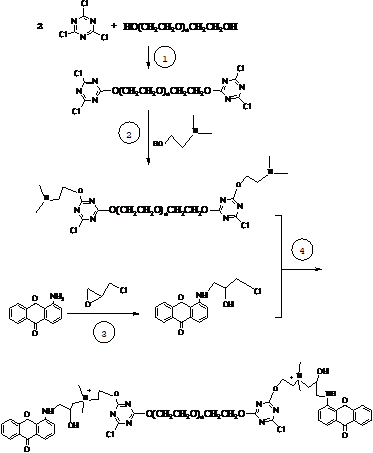
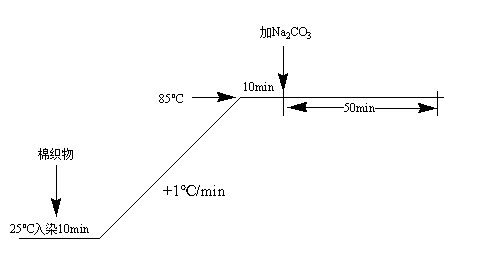
您可能感兴趣的文章
- 改性壳聚糖的合成、性质及其应用的研究进展综述外文翻译资料
- 染料与表面活性离子液体相互作用的光谱研究外文翻译资料
- 热力学,结构和动力学的原子论见解离子液体1-己基-3-甲基咪唑六氟磷酸盐分子动力学研究外文翻译资料
- 仙人掌果肉中的倍他青色素外文翻译资料
- 同轴静电纺丝法制备TiO2@CdS/PVA复合纳米纤维毡及其光降解催化性能的 研究.外文翻译资料
- 一种用于人体辐射散热的双向功能纺织品外文翻译资料
- 抗菌抗氧化剂电活性注射水凝胶作为皮肤创面愈合止 血粘连的自愈创面敷料外文翻译资料
- 二萜异斯特维醇三苯基溴化膦阳离子的合成及其 在海胆胚胎模型中的抗分裂活性外文翻译资料
- 异斯特维醇的制备及其与y-环糊精的包合物外文翻译资料
- 不同食品模型中非营养 甜味剂、甜菊糖和三氯蔗糖的提取效率分析外文翻译资料




